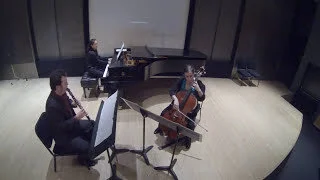designed aleatory
The quarrel which determinism has with chance fortunately has nothing to do with this or that psychological detail. It is a quarrel altogether metaphysical. Determinism denies the ambiguity of future volitions, because it affirms that nothing future can be ambiguous. But we have said enough to meet the issue. Indeterminate future volitions do mean chance. Let us not fear to shout it from the house-tops if need be; for we now know that the idea of chance is, at bottom, exactly the same thing as the idea of gift,--the one simply being a disparaging, and the other a eulogistic, name for anything on which we have no effective claim.
The Dilema of Determinism
William James
I use the term designed aleatory to describe techniques ranging from structured improvisation in jazz or other historical traditions to the limited use of chance in the selection of pitches, to the reorganization of form of the events, to a splitting (or abandonment) of the shared pulse in otherwise traditionally notated scores.
Aleatory is a common term to describe particularly 'open' forms of the musical 'work'. And while the mathematical (and gambling (and RPG)) associations of 'throwing dice' are compelling, I would suggest a deeper consideration of the 'open work'. American Pragmatic philosopher C.S. Peirce suggests tychism as a term for the transition of energia to dunamis, potential to actuality; this was later explicated by his friend William James as the “suggestion [that] order results from chance-coming.”
Bird-like Things in Things like Trees, though strongly ekphrastic, involves extensive improvisation, and notational practices that leave durations of texture and color to the performers. Forks of Buffalo is a case where the form, the sequence of sound events, remains open to decisions on the fly. Alcyone is a quartet in which the players change position continually, playing trios, duos, and solos in configuration suggested in the score, but determined by the architecture of the hall.
Piano Quartet #1
In this work for violin, viola, cello, and piano there is a mixture of fairly freem improvisation, ‘open pulsed’ sections, in which meter and beat dissolve into and restablish themselves. Its surface aesthetic owes much to the punk and prog rock of my youth while its structure derives from the harmonic structure of more ‘learned’ study.
Etude: ‘Aion & Chronos’
The archetypal cat-and-mouse between composer and performer that have defined the etude for centuries continues physically and technically, but also rhetorically and formally. In Etude for Clarinet, Cello, and Piano, No. 1 metered ostinato passages put forward glacially-paced harmonic motion while free-pulse sections bring sequential, symmetric migrations of material through pitch-space. This is a study of temporality as revealed in performance.

